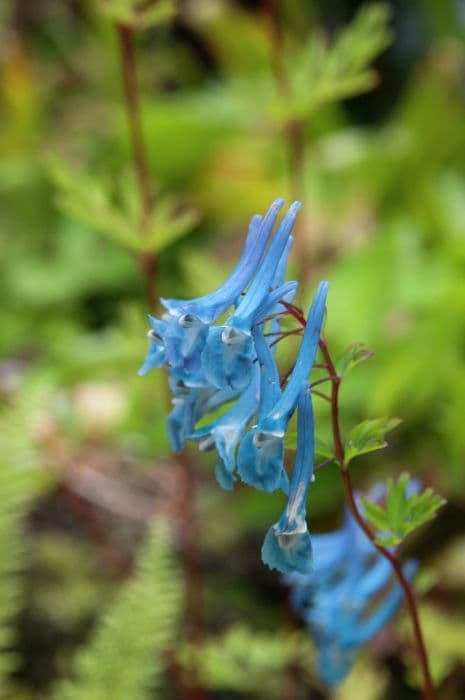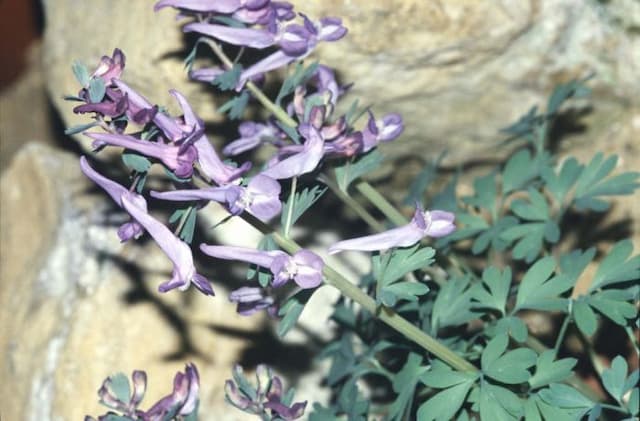Fumewort Corydalis solida

ABOUT
The plant known as fumewort features a delicate structure with a clump-forming habit. Its foliage is composed of compound leaves that are lacy and fern-like, creating an intricate and soft texture. The leaves are usually a deep green color, providing a lush backdrop for the blooms. The flowers of fumewort are the most distinctive feature, emerging in early spring. They are tubular and intricately shaped with a spurred end, resembling little helmets or caps. The blooms come in a palette of colors that can range from pale pink to deep purples, often with subtle or more pronounced variegations. These flowers are arrayed in racemes, which means they grow in a cluster along a single unbranched stem. In addition to its attractive foliage and flowers, the plant forms a capsule-like fruit that contains the seeds which can be dispersed when the fruit splits open. Fumewort is a harbinger of spring, as it blooms early in the season, bringing color to woodland settings, gardens, and naturalized areas. It tends to go dormant after flowering, disappearing for the remainder of the summer, and leaving behind the bare ground or other plants to fill in the space.
About this plant
 Names
NamesFamily
Papaveraceae
Synonyms
Fumewort, Bird-in-a-Bush, Hollowroot
Common names
Corydalis bulbosa, Corydalis halleri, Corydalis inflexa, Corydalis marschalliana, Corydalis solida subsp. marschalliana, Fumaria bulbosa, Fumaria halleri, Fumaria solida.
 Toxicity
ToxicityTo humans
Corydalis solida, commonly known as fumewort, is not typically considered highly toxic to humans. However, like many plants, it contains alkaloids that can be harmful in large quantities. If ingested in significant amounts, fumewort could potentially cause mild stomach upset and should be treated by seeking medical advice. It is not considered a commonly ingested plant, and accidental poisoning is rare.
To pets
Fumewort is not well-documented as a highly toxic plant to pets, but it does contain alkaloids which can be harmful if ingested in large quantities. Pets, especially dogs and cats, might experience mild gastrointestinal upset if they consume parts of the plant. If you suspect your pet has ingested fumewort, it is advisable to consult a veterinarian as a precaution. The symptoms may include vomiting or diarrhea, though significant poisoning is not common.
 Characteristics
CharacteristicsLife cycle
Perennials
Foliage type
Deciduous
Color of leaves
Green
Flower color
Varies
Height
6 inches (15 cm)
Spread
6 inches (15 cm)
Plant type
Bulb
Hardiness zones
5
Native area
Europe
Benefits
 General Benefits
General Benefits- Ornamental value: Corydalis solida, commonly known as Fumewort, has striking spring flowers that add vibrant colors to gardens and landscapes.
- Early blooming: It blooms in early spring, providing an early source of nectar for pollinators when few other flowers are present.
- Drought tolerance: Once established, Fumewort is relatively drought-resistant, making it suitable for gardens in drier climates or for xeriscaping.
- Shade tolerance: Fumewort can thrive in shaded areas, making it an excellent choice for woodland gardens or darker spots where other plants might struggle.
- Ease of care: It is a low-maintenance plant, requiring minimal upkeep once it has settled into its location, which is beneficial for novice gardeners or those with limited time.
- Deer and rabbit resistance: Fumewort is not a preferred food source for deer and rabbits, which reduces the risk of damage from these animals.
- Naturalizing: Fumewort is capable of naturalizing and spreading to form beautiful colonies, making it a great option for filling in large areas over time.
 Medical Properties
Medical Properties- Pain relief: Corydalis solida has been used in traditional medicine for its analgesic properties.
- Sedation: The plant may have sedative effects that aid in the treatment of insomnia and anxiety.
- Cardiovascular health: It might have a role in managing heart conditions, although this use is not well established scientifically.
- Anti-inflammatory: The constituents of Corydalis solida may have anti-inflammatory properties.
- Menstrual discomfort: It has been traditionally used to alleviate menstrual cramps and discomfort.
 Air-purifying Qualities
Air-purifying QualitiesThis plant is not specifically known for air purifying qualities.
 Other Uses
Other Uses- Corydalis solida, commonly known as fumewort, has been used in the past as a yellow dye for wool as the plant can produce a range of yellow hues.
- The tubers of fumewort may be ground up and used as a starch to stiffen textiles, similar to how other starches are used in laundering.
- Although not a common ornamental plant, fumewort can be cultivated in gardens for its attractive early spring flowers that add color to shady areas.
- Fumewort has been utilized in floral arrangements, especially for spring bouquets, due to its delicate and distinctive flowers.
- Some cultures have considered the plant to be a symbol of good luck and have used it in superstitious practices and as a charm.
- In certain regions, fumewort has been used as a part of traditional rituals and ceremonies associated with the early spring season.
- Due to its inherent bitterness, fumewort has been used to deter pests from gardens, serving as a natural pest repellent.
- Fumewort's dense growth can be beneficial for soil stabilization in areas susceptible to erosion, providing ground cover and root structure.
- The plant may also be utilized in companion planting to benefit other plants that prefer similar shady and moist conditions.
- Enthusiasts of natural inks have sometimes experimented with fumewort as a potential source for creating botanical inks for art and calligraphy.
Interesting Facts
 Feng Shui
Feng ShuiThe Fumewort is not used in Feng Shui practice.
 Zodiac Sign Compitability
Zodiac Sign CompitabilityThe Fumewort is not used in astrology practice.
 Plant Symbolism
Plant Symbolism- Hope: Corydalis solida, commonly known as Fumewort, often blooms early in spring, symbolizing hope and the anticipation of better times following the winter season.
- Resolution: The resilience of Fumewort to bloom in early spring, sometimes through snow, represents overcoming adversity and an embodiment of resolution.
- Elusive Beauty: Due to its brief flowering period, Fumewort can symbolize the fleeting nature of beauty and life, reminding us to cherish transient moments.
- New Beginnings: As a spring flower, Fumewort is often associated with new beginnings, rejuvenation, and the start of a new cycle in nature.
 Water
WaterFumewort prefers evenly moist soil, particularly during its growing season in the spring. Water the plant with about 1 inch of water once a week, but always check the soil moisture before watering; it should be slightly damp at a depth of an inch. In the absence of rain, you may need to water more frequently. Avoid overwatering, as fumewort does not like soggy conditions. Reduce watering after the foliage dies back post-flowering, as the plant enters dormancy.
 Light
LightFumewort thrives in partial shade where it can receive dappled sunlight, ideal for mimicking its natural woodland habitat. It can also tolerate full shade, making it well-suited for spots under trees or in the shadow of buildings. Avoid placing fumewort in full direct sunlight, as this may be too intense and can lead to foliage damage.
 Temperature
TemperatureFumewort does best in a temperate climate with temperatures ranging from 50 to 75 degrees Fahrenheit. It can tolerate cold down to about 20 degrees Fahrenheit but is not suited for extreme heat. The ideal temperature conditions are the cooler end of the range, as fumewort goes dormant during the hot summer months.
 Pruning
PruningPruning fumewort is generally not required except for the removal of spent flowers to maintain a tidy appearance and prevent self-seeding, if not desired. The best time for this light pruning is after the flowers have faded, usually late spring or early summer. Pruning can also include cutting back the foliage after it has died back naturally.
 Cleaning
CleaningNot needed
 Soil
SoilThe best soil mix for Fumewort (Corydalis solida) should be well-draining with a high organic matter content. A mixture of garden soil, peat, and sand or perlite is recommended. The ideal pH for Fumewort's growth ranges from 6.0 to 7.5.
 Repotting
RepottingFumewort (Corydalis solida) generally doesn't need frequent repotting as it's a tuberous plant; repotting every 2-3 years should be adequate. It's best to repot the plant in the autumn after the foliage has died back.
 Humidity & Misting
Humidity & MistingFumewort (Corydalis solida) prefers moderate humidity levels but is adaptable to the typical humidity found in most garden environments. Extreme humidity is not required for its growth.
 Suitable locations
Suitable locationsIndoor
Place Fumewort in bright, indirect light and cool temperatures indoors.
Outdoor
Plant Fumewort in partial shade and well-drained, fertile soil outdoors.
Hardiness zone
3-8 USDA
 Life cycle
Life cycleFumewort (Corydalis solida) begins its life cycle as a tuber underground, which will sprout in early spring. As temperatures warm, the plant develops basal leaves that are compound and often finely divided, leading to the emergence of a flower stalk. This stalk bears clusters of small, tubular flowers usually in shades of purple, pink or white, which are pollinated by insects, especially early-season bees. Following pollination, the flowers give way to dehiscent seed capsules that release numerous small seeds when mature. The seeds are dispersed by ants, a process known as myrmecochory, which helps to spread the plant to suitable new growing locations. After seeding, Fumewort dies back to its tuber and goes dormant for the rest of the year, conserving energy to begin the cycle again the following spring.
 Propogation
PropogationPropogation time
Spring
The most popular way to propagate Corydalis solida, commonly known as Fumewort, is by dividing its tubers. This is typically done in the autumn after the plant has died back. Gardeners carefully dig up the clumps of tubers, ensuring not to damage them. Each clump is gently broken apart into individual tubers, taking care not to break the fleshy parts. These tubers are then replanted at a depth of about 1 to 2 inches (2.5 to 5 centimeters) in well-draining soil and spaced about 3 to 4 inches (7.6 to 10 centimeters) apart to allow for adequate growth. Adequate moisture and protection from extreme cold are necessary for the new plants to establish themselves and thrive.









